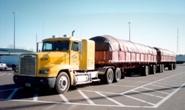Shipping and Logistics

Freight Update for August and September
Written by Sandy Williams
September 27, 2016
Freight reports are mixed for August and September. Seaborne freight is seeing a resurgence in volume and pricing while U.S. truck, rail and river freight has been somewhat weak. August was reported as a good month for cargo shipments on the Great Lakes and St. Lawrence Seaway.
Seaborne
An increase in China demand for coking coal is fueling price increases for cape and panama vessels, according to the latest MID-SHIP Report. China has cracked down on environmental issues including a reduction of domestic coal mining, prompting a resurgence of imports of coal into the country. Iron ore demand has also picked up in China, with 990 million tons of ore imports expected for the total of 2016.
Grain exports from the Northern hemisphere are expected to add to stronger shipping prices and volume.
Record level scrapping of bulk carriers this year has tightened up the oversupply problem. Hyundai Heavy Industries is planning to reduce its shipyard production capacity by 30 percent due to scarcity of new vessel orders. Ship building orders in general, said MID-SHIP, are down by 60 percent compared to 2015.
The Baltic Dry Index continues its recovery, posting at 941 at the end of last week (Sept. 23).
River
River conditions have moderated on the Illinois River after heavy rains caused high water conditions but have contributed to high water conditions on the lower end of the Upper Mississippi. Navigation on the Upper river has been restricted to “daylight only” and tow sizes have been reduced for southbound navigation. The Kentucky Lock on the Tennessee River will be closed completely from October 9-13 for repairs which will result in a detour that will add 24 to 48 hours to normal transit times.
Barge rates have been flat but are expected to rise as grain shipments pick up. Coal exports continue to decline and are on pace for the lowest export market since 2007. Tonnage has shifted from barge to rail for coal resulting in barge lines covering open hoppers for weather sensitive cargo, increasing supply and hold rates in check. MID-SHIP expects the barge market to remain flat for the foreseeable future.
Trucking
The American Trucking Association reported a 5.9 percent year over year jump in truck tonnage in August. ATA Chief Economist Bob Costello noted continued volatility in 2015 making it difficult to determine a clear trend in truck tonnage. “What is clear to me is that normal seasonal patterns are not holding in 2016,” he said.
“Despite a difficult to read August, I expect the truck freight environment to be softer than normal as well as continued choppiness until the inventory correction is complete. With moderate economic growth forecasted, truck freight will improve as progress is made with the inventory overhang,” said Costello.
Flatbed load to truck ratio increased during the week of Sept 11- Sept 17, from 12.2 to 13.2 loads per truck. Spot prices for flatbeds rose 2 cents to $1.89 per mile during the same period. Rates were highest in the Northeast at $2.91 and lowest in the West at $1.67 per mile.
Diesel fuel fell 0.7 cents last week for a price of $2.382 per gallon, keeping diesel essentially flat for nearly five weeks.
Rail
The Association of American Railroads reported weekly freight traffic down 5.3 percent in the week ending September 17 compared to the same week in 2015. Weekly rail traffic was 537,904 carloads and intermodal units. Carloads were down 5.3 percent at 270,336 and intermodal was down 4.9 percent to 257,568 containers and trailers.
Great Lakes & St. Lawrence Seaway
Cargo shipments increased 8 percent year-over-year on the St. Lawrence Seaway in August. “We’ve seen a real rally in August. St. Lawrence Seaway cargo shipments were up 8 percent compared to the same month last year,” said Stephen Brooks, President of the Chamber of Marine Commerce. “U.S. grain exports now match last season’s strong performance. Iron ore shipments have improved as Canadian and U.S. mines have boosted production and we continue to see steady demand for aluminum, cement and asphalt.”
The Lake Carriers Association reports iron ore trade was up 2.9 percent on the Great Lakes and St. Lawrence Seaway, totaling 6,048,409 tons in August. Year to date iron ore trade is up 2 percent to 32,851,570 tons compared to the same period 2015.
“The Port of Cleveland was excited to see an increase in steel shipments throughout August, when compared to July,” said Jade Davis, Vice President of External Affairs, Port of Cleveland in the Chamber of Marine Commerce press release. “We expect continued momentum in our cargo numbers throughout the remainder of the shipping season.”
Cass Freight Index
The Cass Freight Index for August showed shipment volumes and pricing as persistently weak with increasing volatility as inventory reduction continues along supply chains. Shipments in August increased 0.4 percent sequentially but were down 1.4 percent year-over-year. Expenditures decreased 3.3 percent sequentially and fell 6.3 percent year-over-year.

Sandy Williams
Read more from Sandy WilliamsLatest in Shipping and Logistics

Wittbecker on Aluminum: US-China trade war clobbers cross-Pacific trade
Container shipping lines have sharply increased blank sailings on Transpacific routes in response to escalating trade tensions between the US and China.

Volvo plans to lay off up to 800 workers at US truck plants
The company cited uncertainty about freight rates and demand, regulatory changes and the impact of tariffs.

Trump signs executive order aimed at making US shipbuilding ‘great again’
President Trump on Wednesday signed an executive order meant to breathe new life into American shipbuilding and curb Chinese dominance in the sector.

Great Lakes iron ore trade fell again in March
Recall that shipments also saw a sharp decline in January.

Longshoremen ratify contract with maritime alliance
Nearly 99% of ILA members voted in favor of a new labor deal with the United States Maritime Alliance that covers workers at ports on the Atlantic and Gulf coasts.
